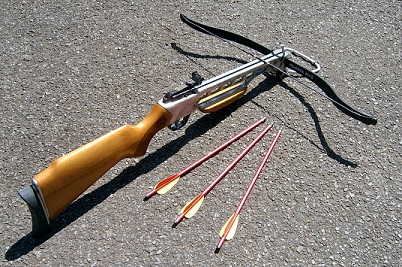Recurve
The type of bow most commonly shot today is the recurve (or Olympic) bow. Materials vary, but most are made of a metal handle with two composite limbs which either bolt or slot into the handle. Composite limbs vary in type but are usually based on layers of fibreglass or carbon fibre. It is also possible to buy wooden recurve bows, though these are not usually used for target archery. Bowstrings are made of dacron or a synthetic material called Fastflight – generally, Fastflight strings are lighter, faster, can take higher tension and are used on newer bows. Recurve bows also have a number of weird and wonderful extra bits all aimed to make the bow (or archer!) more stable and generally aid in accuracy. The sight and arrow-rest sound fairly obvious, but longbows dont have them! The button is a spring-loaded piece of plastic which rests against the arrow and steadies its flight as it leaves the bow. Modern recurve bows are designed so that the bottom limb holds more energy than the top whilst at full draw and so the bow tends to kick up on release unless fitted with a longrod. Short bars (or twins) can be fixed both above and below the longrod if further damping is required; a V-bar attaches to the longrod or back of the bow and is designed to stop the bow twisting on release. Arrows for recurve bows are either tubular aluminium or carbon fibre (some with metal cores). At our field, we ask that you do not use the carbon fibre arrows without the metal cores, as they can be difficult to find.
Compound
Compound bows are also used for target archery. The bows are designed in such a way that the string is constantly under high tension; when the bowstring is drawn, the bow itself does most of the work. Whereas a recurve bow might be between 30-40lbs at full draw, 50-60lb compound bows are not uncommon. However, the compound archer only has to draw around 20-30lb – making this an ideal choice for anyone who doesn’t have the strength (perhaps due to injury) to shoot recurve. Compound bows tend to be much more accurate than recurve – hence why compound and recurve archers don’t compete against each other except on handicap! Compound bows usually shoot with light carbon fibre arrows (with metal cores). At our field, we ask that you do not use the carbon fibre arrows without the metal cores, as they can be difficult to find.
Longbow and Traditional
Traditionally the bow was made from Yew or Elm, with horn nocks and a Hemp or silk string. Arrows from Ash with horn reinforced nocks, feather fletching and steel points (type 16 or Bodkin).
Modern day longbows are little changed and are made from yew or laminated woods to improve cast but still with horn nocks. To be considered a longbow for a gent it has to be over 5′-10″ in length. The string is either Dacron on lower poundage bows, with the faster material used for tournament bows. Still with out arrow rest or any attachments the longbow is the purest form of archery.
The arrows for modern day archery are similar to the traditional, have wooden shafts, feather fletching, but plastic nocks and brass piles.
Like all modern archery, longbow archers only compete with other longbows.
Handicaps and classifications are maintained for longbow as all other disciplines.
All types of archery are shot with the longbow, Target outdoor, indoor, Field, Clout, Wand, Flight, and Marks shooting. Wand and Marks only shot by longbow.
The longbow in modern archery is alive and well, traditionalists keep the faith.
Barebow

The simplest description of this type of bow is a Recurve bow but without a Sight, Clicker or Long Rods. Weights can be added but must be directly fixed to the handle. More commonly seen at field shoots, Barebow is becoming more popular for target shooting with Classifications and Handicap tables being produced by Archery GB. A few manufacturers supply specialist Barebow handles with pockets for additional weights however most Barebow archers shoot the more easily available standard Recurve bow but without sight etc…Arrows are the same as used with Recurve bows, e.g. either aluminium or carbon fibre. At our field, we ask that you do not use the carbon fibre arrows without the metal cores, as they can be difficult to find.
Crossbow

Hardly ever seen on the shooting line they are an extremely specialized bow. Very few Crossbows available in the UK are in accordance with the ArcheryGB specification for this bow type and as such cannot be used at ArcheryGB clubs. Strict limits on poundage, draw length, limb length, limb design and many other aspects make choosing a compliant target crossbow difficult. Probably for historic reasons Crossbows are more popular in mainland Europe than the UK and were banned by Pope Innocent II in 1139. Any one considering this type of bow should familiarise themselves with current UK laws regarding Crossbows which are stricter than those governing general bows. At our field, we ask that you do not use the carbon fibre bolts without the metal cores, as they can be difficult to find.